Follow-up
2025. 6. 12
NewsJapan Guide Dog Association conducts periodic follow-ups with clients who have completed class training and have debuted as a guide dog unit. A guide dog works for approximately eight years and retires at the age of ten. Dogs learn and change every day, and to help them become better guide dogs during those eight years, JGDA watches over both the client and the guide dog, sometimes providing necessary guidance to help them maintain the best possible mobility and lifestyle. In this article, we would like to introduce you to our follow-up services.
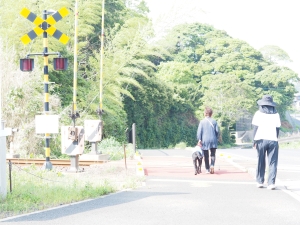
An Instructor on a follow-up.
There are two main types of follow-ups.
The first is regular follow-up. We assess the client and the guide dog's current condition by checking their walks at set intervals, such as one month, three months, six months, one year, and annually after certification.
The second is follow-up as needed. In some cases, we visit clients in response to their requests and consultations, and in other cases, we respond to issues while the clients stay at JGDA’s facilities.
The unit introduced here is Kahoru and her guide dog, Alpha. Four years and seven months have passed since their partnership began, and we visited Kahoru in Hirado City, Nagasaki Prefecture, where she resides, for a regular annual follow-up.
Kahoru has been using guide dogs since 1977, and Alpha is her eighth partner. Hirado City is a historic town that once had a thriving trade with foreign countries. Today, it is a picturesque area with remnants of European culture and stunning natural beauty. The hot springs and fresh seafood are also attractive.
Kahoru's request for this follow-up was to inspect the roads around her home that had been altered by road construction and to gather information for safe walking.
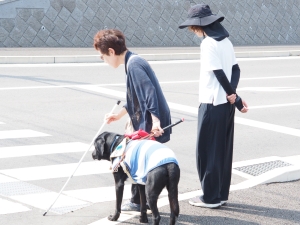
Kahoru searching for the escort zone with her long cane.
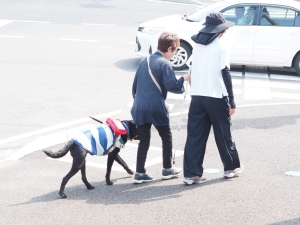
The instructor guides Kahoru to practice the crossing again.
The new crossing had an escort zone (crosswalk Braille line). Kahoru wanted to stop at the position where the escort zone was before crossing and walk on the escort zone during the crossing. To ensure she could reach the escort zone, we repeatedly walked to confirm her position from the turn.
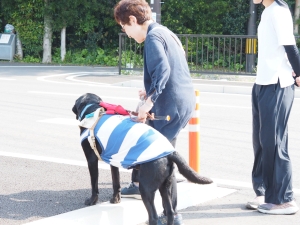
Alpha shows the step to the bus stop.
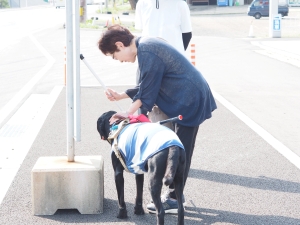
Kahoru praises Alpha for finding the bus stop.
The construction changed the structure around the bus stop that she uses regularly. The path to the bus stop had been sloped, but now there were large steps. Alfa confirmed that the path to the bus stop was not particularly different from before.
On the second follow-up day, we had Kahoru and Alpha walk through the places we had identified on the first day, rechecking them. It was not about avoiding wrong turns but about recognising when making a mistake and correcting it safely from there.
During the two days of walking, we were also able to confirm the daily routine of Kahoru and Alpha. There was much for us instructors to learn from Kahoru, who has spent time with a number of guide dogs.
JGDA will continue to provide ongoing support, enabling users and guide dogs to coexist in harmony.
We later received an e-mail from Kahoru, which we would like to share with you.
"We, vision-impaired people, sometimes get lost even with slight changes, such as when a new road is built or an old road is improved.
This follow-up session concentrated on the areas I was concerned about, so I feel that I will be able to walk well from tomorrow.
But I'm sure I will get lost many times because that's just me, but I'm looking forward to walking happily and laughing with Alpha."






